
|   |

|   |
Naada - Festival of Music: From within to the skies - Dr. S D Desai e-mail: sureshmrudula@yahoo.co.in November 24, 2013 Come Hemant, a busy season of performances sets in here in Ahmedabad. At Darpana Academy’s Natarani, it opened with a Theatre Fest earlier. From November 14 to 19, it was time for Naada - Festival of Music. Nearly every central performer at the festival was remarkably rooted in the tradition and had the indomitable desire to reach out to the contemporary in a special way. They caught the imagination of the young listeners in the audience. The range of Tritha Electric’s trained voice rises from within and, going up, movingly touches the skies. Irrepressible and brimming with innovative ideas, she added quite a bit to her engaging inaugural performance at Naada. With the black of her outfit relieved by a sparkling red and the exotic and ethnic of the minimalist ornaments sitting pretty on her hands and ears, not for a moment did she stand still on her silvery high heels. In controlled abandon, flashing a smile, she kept hopping about in elegant rhythm. Around twelve songs she sang demonstrated her vocal skills in sublime classical in Dhrupad and Tarana to a playfully crazy number from her album Paglee. The three French instrumentalists added to the excitement. Why did she think incidentally – despite Jayadev - that Radha’s agony was not given voice? 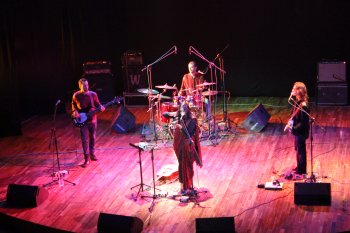 Tritha 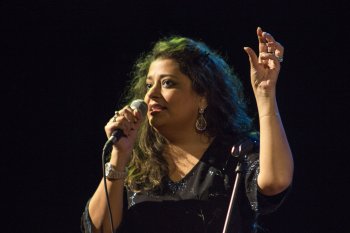 Ishita Ganguli Ishita Ganguli let her voice flow with “Sujalaam sufalaam malayaja-sheetaaam… maataram, vande maataram” as the opening line of her first song. Thinking perhaps that today at Naada, strong rhythm was not going to rock and jerk, the effusive and the young were conspicuous by their absence. One would love to listen, eyes lowered and swaying like her, to Ishita’s nuanced subdued singing of Tagore’s lyrical lines like “Praan chaahe nain na chaahe” and “Baaje re baaje damaru baaje.” They touched inner chords of sensitive listeners. In the latter half of her “Ekla chalo,” she gave a flavour of her genre by giving momentum and energy to the meditative lines of the song with a touch of the western style of music. In a reversal of roles, men in the audience coyly whispered together the line ‘I feel the rhythm’ she suggested as part of “Baaje re baaje” and the women emerged clear winners. “Saiya-n tori nagari sundar atisundar…” Anurag of Indicus sings full-throated, a guitar in hand. With his broad strong frame, controlled agility and mane reaching his waist, he could have been Michelangelo’s model! Later, silence descends, even western instruments, percussion and wind, get soft and the air carries his voice like flakes of snow, “Mora saiya-n mujhse bole naa…” Strongly does the identity of each instrument emerge in song after song. Kabir, Meera, Khusrau… and all. Finally, the voice opens up again and you have Jalaluddin Rumi: “Naa koi jisma mera…” Indicus blazes a trail to the modern young with the idiom they are more comfortable with. Judiciously used, jazz can soften and carry poetry and mysticism. Indicus calls their style eclectic. Well, with those influences a modest genre does emerge. They need to not drown words as in Meera though. 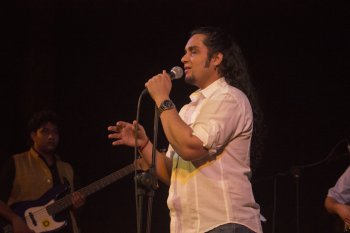 Indicus 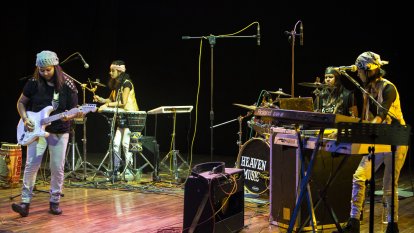 Hurricane Gals Irrepressible Hurricane Gals – like their river the Brahmaputra! The endearing girls from Assam, two of them in their teens, gradually so came into their elements that one felt they would sing the whole night. The initial hiccups were left behind and, delightfully in sync they soon caught the fancy of the young listeners with “Mar jaiya-n tere bin” and “Tere naam se jee loon.” A bubbly lead vocalist Manomi then had Kaberi do a delectable prelude to Bihoo on Dhol and began crawling up to the hearts of one and all. Explaining the playfully romantic dialogue in verse lines between boys and girls she had Mallika, Sonal, Pooja and Priya on their feet. The other stylish petite teenager Mumpy created all those enchanting sounds of the land on her keyboard. Power and rhythm flowed from Arju’s drums. A demure Jonali gave the bass support. Counting beats and classifying rhythm patterns have their place. Anuradha Pal, beautiful in her brilliance when on stage, clear as much in her articulation as on the tabla, relates the sounds, regular in their aavartans, to varying contexts in everyday life. She calls her unusual performance a Jugalbandi – one between her traditional base and contemporary explorations and between Purush and Prakriti with raagas Shankara and Durga in the background. With rise and fall in pitch and pace of beats, she relates them to man-woman dialogue, Lord Nataraj’s damaru, Radha’s sulking mood, a horse’s gallop, a train crossing another and finally thunder, lightning and rain. One gets reminded of Birju Maharaj talking about rhythm and movement in nature. 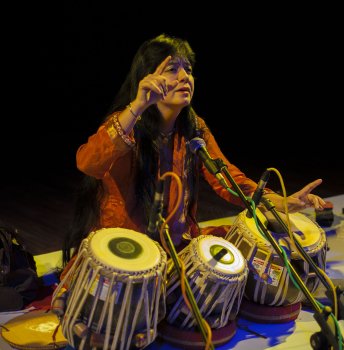 Anuradha Pal 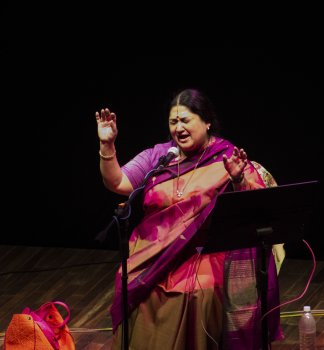 Shubha Mudgal Classical is her base and its excellence connoisseurs of music admire. Shubha Mudgal’s niche is in the passion and intensity her huskily evocative voice carries in lyrics particularly of social significance. Popular and romantic numbers like “Ritu saavan ki” and “Tere baanke nayano ne kaisa jaadu daala” received rousing applause. What lent character to her performance and added to her pahechaan was a bunch of tender lyrics and songs of social significance. Gulzar’s “Kal ki raat tere sang gujari” in Aneesh Pradhan’s lower octave tunes came across like rose petals. “Mujhe meri raah pe chal lene do…” highlighted that in her performance each of the instruments emerges distinct and yet they amalgamate. On subdued single beats (again Aneesh) wartime abuse of women at home was tellingly conveyed through Zehra Nigah’s simple images of choola, tota, roti, Quran and ‘jaanwar.’ The gem, however, was Prasoon Joshi’s poignant lyric “Baabul jiya mora ghabaraay…” that has a folklorish flavour. Not for me gold, jewellery or a kingdom, the eligible girl sings, “Mujhe lohaar ke ghar de dijo… jo mori jhanjhire-n pighalaye…”! Dr. SD Desai, a professor of English, has been a Performing Arts critic for many years. Among the dance journals he has contributed to are Narthaki, Sruti, Nartanam and Attendance. His books have been published by Gujarat Sahitya Academy, Oxford University Press and Rupa. After 30 years with a national English daily, he is now a freelance art writer. He guest-edited attendance 2013 with the theme Classical Dance and Modern Times. |